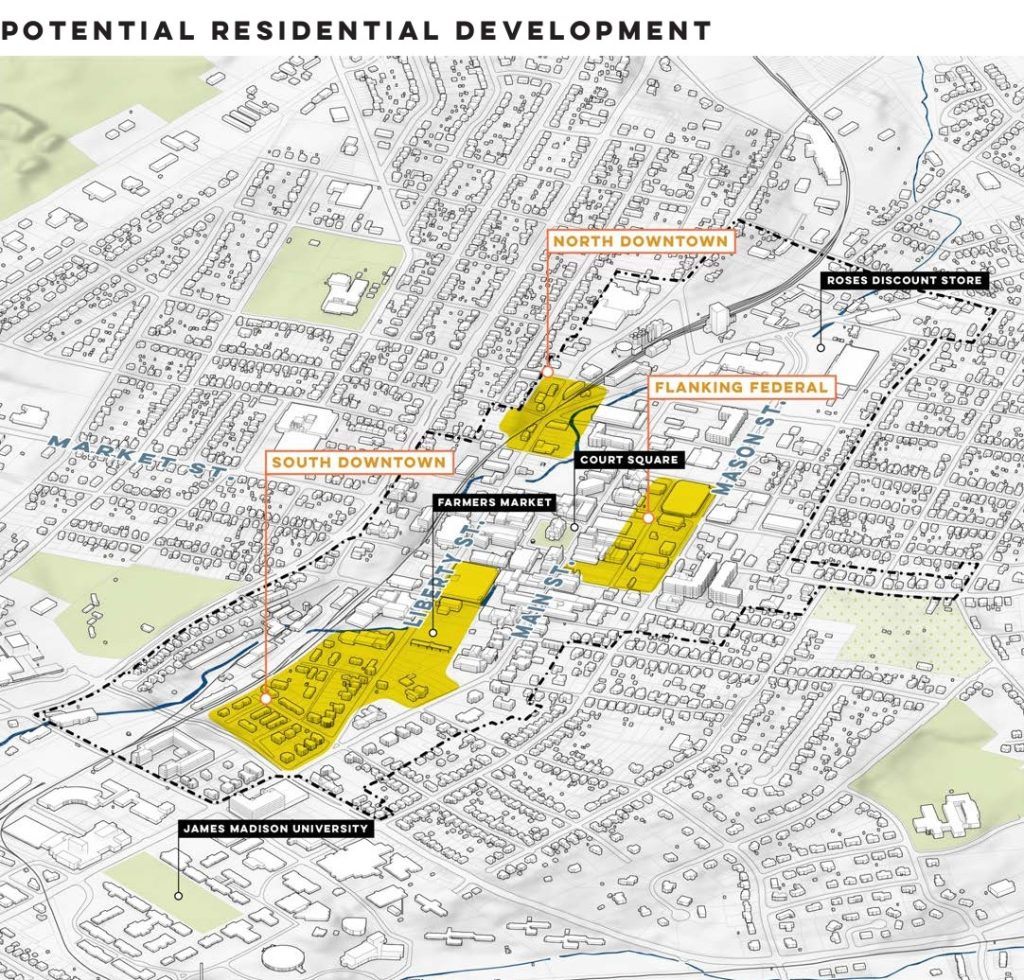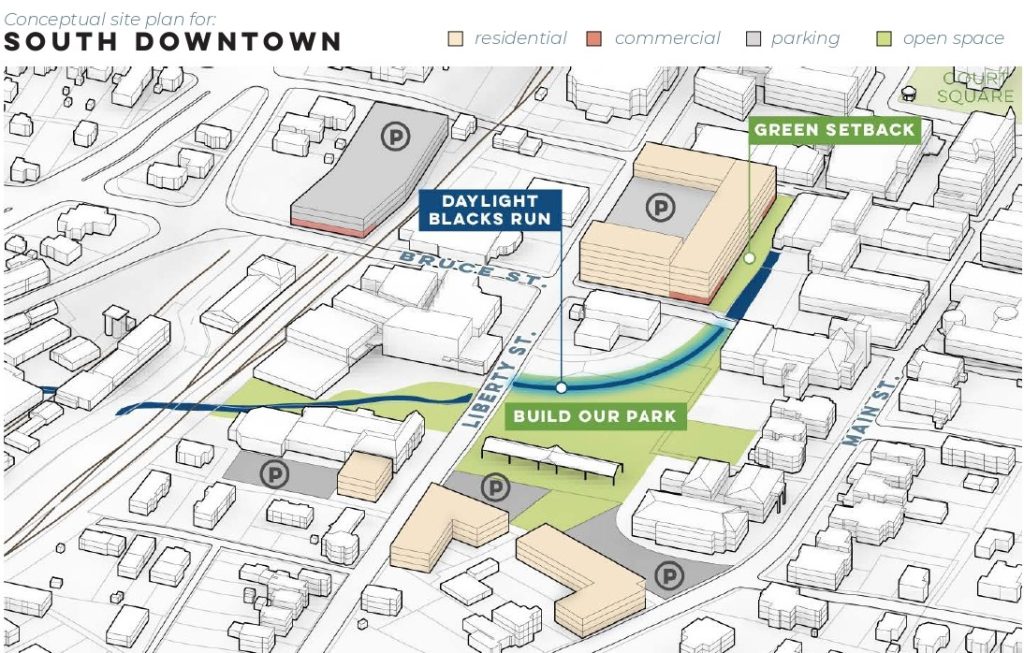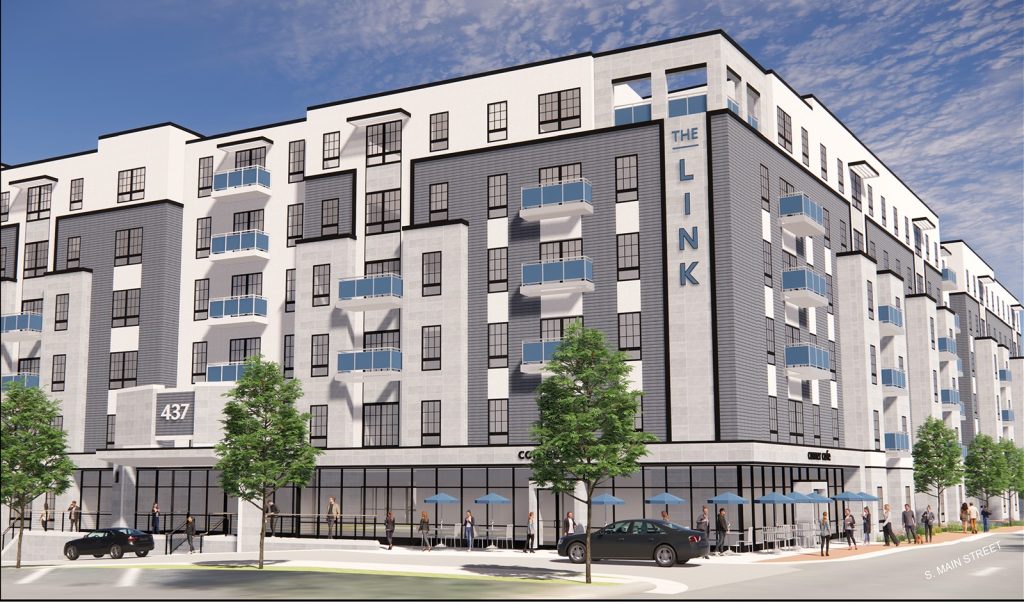An Economic Boost for Harrisonburg
We’re turning 473 S Main St into an engine for downtown’s growth, longevity and prosperity.
The Link infuses as much as $100M in private investment and $600,000+ per year in taxes into Harrisonburg. This new revenue funds critical city needs and services.
With up to 265 units and 5,000 square feet of retail space, The Link will bring new customers to our existing small businesses and provide an opportunity for more commerce downtown.
That’s why so many local businesses have voiced support for this project.
The Link at a Glance
More Affordability
- Up to 265 total apartments
- 100+ studios and one-bedrooms
- Limited to 88 four-bedroom apartments
- Boost in local supply
- At 2.1%, Harrisonburg has Virginia’s lowest rental vacancy rate
New Opportunities
- Corner retail storefront along Main St
- Doubling commercial space up to 5,000 sqft from 2,000 sqft
- Exterior seating
- Enhanced pedestrian access
Easier Parking
- 480 parking spaces
- 65 spots dedicated for public/city use
- 14 EV chargers
- 136 total exterior bike spaces
Better Connectivity
- $100k invested in the ‘Build our Park’ initiative
- Adjacent to the Liberty St bike lanes/cycle track
- Paul Street Extension alleviates traffic issues on Grattan Street Crossover
- Eliminates commercial dead zone on Main Street
Harrisonburg’s 2040 plan lays out the need for more housing in our city, particularly in and around downtown.
The Link, the first major apartment project in Harrisonburg in 16 years, will address our region’s housing shortage and bring new residents closer to our city’s small businesses.
This site is within walking distance of both downtown and JMU, reducing the need for car trips. This reduces traffic impacts and improves our city’s sustainability.
The Link will have 136+ secured bike parking spaces and 14 EV charges to further enhance our commitment to Harrisonburg’s sustainability goals.


Harrisonburg can meet our shared goals of more housing supply, supporting local businesses, increasing walkability and growing our economy by delivering on the 2040 Plan.
The Link will build on the success of developments like Urban Exchange to create more vibrancy downtown and spur growth and investment in our city. The Link also provides 65 parking spaces for the public, support the expansion of local parkland and provides funding for the Paul Street extension to improve traffic circulation.
It’s time to start work on the 2040 Plan. It’s time to build.
Explore Our New Design
| Before | After |


We want to hear from you!
Share your feedback, voice your support or suggestions
Links & Resources
Frequently Asked Questions
The Link has already undergone substantial change during the course of our conversations with neighbors and the community. We’ve revised the architecture from modern to traditional, better matching the downtown, increased the number of vehicle and bike parking spaces, reduced the number of 4-bedroom units and increased studios/1-bedrooms apts, expanded the size of the corner retail space and added additional screening of the parking structure.
We’re continuing to meaningfully listen to Harrisonburg residents as we work to deliver this critical project.
Yes! We commissioned a verified study that shows The Link will generate at least $600,000+ per year in taxes, with an additional $750,000 generated over the 24-month construction period. This will reduce pressure for the city to raise taxes from other sources, including existing homeowners and businesses.
Our latest traffic study shows that The Link’s impact on traffic will be minimal. Within easy walking and biking distance to both downtown and JMU, and with ample bike parking, daily car trips are reduced.
Harrisonburg hasn’t seen a new multifamily building downtown in over 16 years. This has forced development into the county, causing taxes to rise in the city and exacerbating traffic congestion. The Link will add 265 modern homes where people want to live, near jobs, JMU and downtown shops. This helps relieve housing pressure on older neighborhoods and prevents more traffic-inducing sprawl.
The Link is not a dorm. It’s a professionally managed, mixed-use apartment community with a diverse mix of units. At least 40% of residences will be studios or one-bedrooms—housing types that JMU doesn’t provide—making it attractive to young professionals and downtown workers, in addition to graduate and undergraduate students. This layout is atypical of student housing, which typically has a large majority of 4- and 5-bedroom apartments.
The Like will be professionally managed and cater to residents who want a peaceful, rewarding living environment, not a party pad.
Breathing new life into downtown is essential to supporting Harrisonburg’s small businesses. With hundreds of new residents living two blocks from Main Street, shops, restaurants and services will see a significant boost in foot traffic. Dozens of local businesses and residents have already signed petitions supporting the project and have uniformly agreed that this project is essential for a healthy future of downtown.
The Link will help draw and anchor a young professional population that values urbanism and walkability.
The housing market is like a game of musical chairs. Just substitute homes for chairs. If you add more people without increasing the number of seats, some people won’t be able to sit. In real life, this pushes the cost for housing up as a housing shortage allows wealthier residents to price out working-class families.
By adding new supply to the market, The Link will prevent older, existing housing options from becoming unaffordable. Without projects like these, people don’t go away; they just push other people out of the finite number of homes.
Harrisonburg currently has a ‘shadow market’ of single-family homes that are rented as group homes. By adding more apartments, we also reduce the number of renters competing for existing homes, increasing opportunities for families to buy or rent their own house.
No, our report was conducted according to rigorous state and local standards, capturing traffic data while JMU was in session. Our methodology was thoroughly vetted and approved by city officials to ensure regulatory compliance.
Not at all, and this possibility has been thoroughly considered and tested. Our study showed that utilizing the existing MLK Jr Way route would be faster than the Paul St route, even during rush hour. Existing traffic calming measures on Paul St will remain effective in deterring significant use by non-local traffic.
Our study found that The Link will have a very limited impact on surrounding roads. This is largely due to the building’s central location, which is easily accessible by several different roadways, dispersing traffic from impacting any one corridor. Research also shows that mid-rise apartment buildings generate much less traffic per unit than other, less dense options. When combined with The Link’s excellent walkability and bikeability, our study concluded that there would be no major traffic impacts.
Helpful Files & Documents
Thank you for taking part in our project. Please click below file(s) to download and save on your device.
| Document | Date |
|---|---|
| Architectural Renderings – NEW | 11/12/2025 |
| Building height Study_Harrisonburg | 11/04/2025 |
| Article_2.1% Harrisonburg vacancy_LOWEST in VA | 04/16/2025 |
| Architecture: Side-by-side comparison | 10/13/2025 |
| Charlottesville City Council Discussing Smart Growth | 09/02/2025 |
| Coverage: Friendly Urbanist – 08/07/25 | 08/07/2025 |
| Coverage: Friendly Urbanist – 08/12/25 | 08/12/2025 |
| Coverage: Harrisonburg Citizen – 08/10/25 | 08/10/2025 |
| Excerpt: Plan 2040 Report | 10/13/2025 |
| City Staff Report – 07/09/25 | 07/09/2025 |
| B1 vs R3 comparison | 10/13/2025 |
